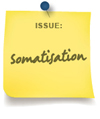Western psychiatry asserts the superiority of psychological expression over that of somatisation. However, as there is no conclusive empirical evidence to support this position the primacy given to psychological processes over physical expression has little use in understanding non-Western cultures.
Somatisation
Pre Course Reading for CALD 9
eCALD Supplementary Resources

Another way distress can be expressed is through somatisation.
Somatisation generally refers to the presence of physical symptoms where there is no physical pathology evident – the body becomes the vehicle for the expression of the social or emotional distress (Kirmayer et al., 2003; Kirmayer & Young, 1998).
Somatisation of psychological or psychiatric symptoms is reported to occur more often in those from collective cultures. However the term may be a misnomer since the concept of somatisation derives from the distinction Western cultures make between mind and body – many cultures do not make the distinctions between the physical and non-physical aspects of self in the way Westerners do.
Western psychiatry tends to categorise thoughts and emotions as the domain of the individual. Collective cultures usually do not see the emotions as internal to the individual, but rather as inter-personal experiences. This has particular bearing on the diagnosis of depression.
When the term ‘somatisation’ is used clinically (within a Western framework), it infers various underlying processes:
- A group of psychiatric disorders (somatic symptoms and related disorders in DSM V) (APA, 2013a).
- The conversion of psychological conflict into physical symptoms.
- The externalisation of cognitive responses to stress.
- A pattern of behaviour in which emotional or social problems become obscured or denied (in some psychodynamic views, an immature defence).
- A coping mechanism in anthropological and cultural psychiatry.
- A means to describe feelings of sadness or distress in the absence of words or concepts.
These distinctive concepts tend to be operationalised in research as medically unexplained somatic symptoms as hypochondriacal pre-occupations and somatic presentations of anxiety or other psychiatric disorders (Kirmayer & Young, 1998).
Additionally we have the following issues with:
Western psychiatry asserting psychological expression over that of somatisation
Many collective cultures de-emphasising the psychosocial aspects to avoid the stigmatisation of mental illness
The cultural context is pre-eminent. Somatising is often a socially sanctioned expression. Some migrants may come from countries with limited health services where mental illness is associated with extreme states and where there may be no familiarity with psychiatric diagnoses. Many collective cultures avoid the stigmatisation of mental illness by de-emphasising the psychosocial aspects of their distress. This does not imply that they do not experience emotional or psychological symptoms, but rather that they choose not to make them the focus of their distress nor of the clinical consultation. In some cultures, an emotional state may be conceptualised as an interpersonal phenomenon rather than an intrapersonal experience. Ultimately, if we are to accept a systemic model all human experience impacts every level of the system – physically, cognitively, emotionally, socially, spiritually and environmentally.
How people express the experience or distress (somatically, psychologically or spiritually), and the meaning this has for them (individually and culturally) and the forms that the expression takes (contained or expanded). This is what differs across cultures.
It is the task of the clinician to decipher the cues, to contextualise these and then to discern how best to facilitate healing.
